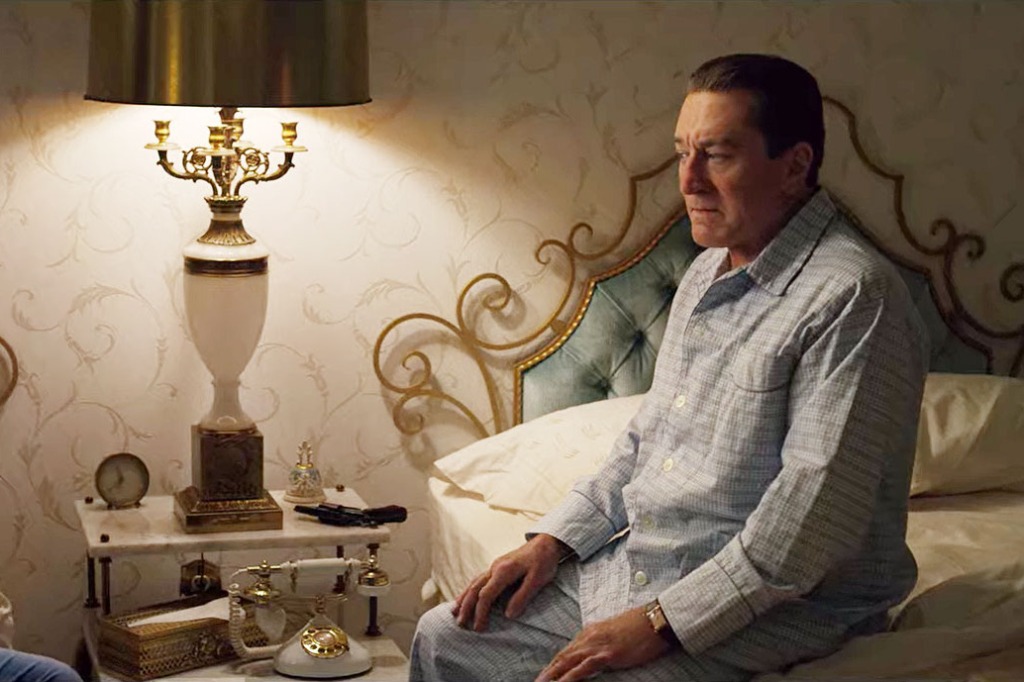
Martin Scorsese has always been such a great contributor to – and champion of, through his preservation efforts – the art of film that it sounds sacrilegious to suggest he’s been a bit hypocritical in attacking big-budget franchise films when he keeps making them himself. The fact is we know what we’re going to get in a Scorsese mob movie (DeNiro, Pesci, R-rated bludgeoning) just as sure as we know what we’ll get in a Marvel film (Downey, Evans, PG-rated bludgeoning).
It’s interesting that Scorsese chose to level this criticism just as he’s releasing a film that marks a significant tonal departure from his usual gangster theme parks. Compared to Goodfellas and Casino, The Irishman is languid and melancholy, the violence mostly muffled, the menace quieter. A more low-key Scorsese feels fitting with our moment of cultural ennui, and his usual cast of wiseguys are clearly relishing what feels like a graceful, reverent send-off of their characters from (Scorsese and real-life) mob history.
The first sign that things are different this go-round is that the movie has two titles. Ticketing apps and theater lobbies announce The Irishman, which sounds like Scorsese’s ‘grander’ movie titles (The Departed,The Aviator), but once in our seats the film we see is titled I Heard You Paint Houses, which has a winking, conversational feel more reminiscent of his looser earlier films like Alice Doesn’t Live Here Anymore. Whether this is due to Scorsese’s inability to pick a flavor, or Netflix stepping in, we don’t know.
The story is set in three main time frames, which required the much-discussed de-aging of the leads DeNiro and Pesci. And while neither ever looks younger than 60, the movie is set in a time period where 30-year-old guys looked 60 anyway, so it all kind of mushes together and works.
If it’s a Scorsese gangster film, we get a narrator, so here it’s the title character, Frank Sheeran (DeNiro), in his oldest phase. From a wheelchair at the nursing home where he lives, Frank relates the story of how he met and began ‘painting houses’ (with blood if you didn’t get it) for mob boss Russell Buffalino (Pesci) and how Russell eventually recommends Frank as a bodyguard for infamous Teamsters boss Jimmy Hoffa (Al Pacino). The relationship between Frank and Hoffa becomes the heart of the narrative, literally and figuratively. Through Frank, we witness the Jimmy Hoffa era of the late 50s until his disappearance in 1975, one of the most tumultuous socio-economic and political periods in American history. This period was also sort of a last hurrah for organized crime, and it feels as if the movie’s sadness stems from this, as if Scorsese misses the world he’s immersed himself in for so long.
DeNiro, for his part, channels that longing into his character, and Frank ends up a fuller and more nuanced creation than DeNiro has shown in a while. Frank has genuine affection for Hoffa, and once things get bad between Hoffa and the mob, Frank’s divided loyalties hollow him out. DeNiro and Pacino exchange dialogue like it’s a dance that neither is leading, speaking in coded language of the inevitabilities of the world they’ve each chosen to live – and likely die – in. It’s two of the best actors in film history locked not in battle but in a back-and-forth deference to each other, and it’s both pretty amazing and profoundly sad to watch.
Pesci is worth the trip as well. He finds a different, softer presentation from his typically volatile mobsters, and it helps that here he doesn’t do any of the dirty work himself. That dichotomy between repulsive and magnetic was always Pesci’s calling card, and watching him play it from a fresh angle makes you realize that no actor has embodied Scorsese’s complicated allegiance to these types of men more than Pesci has, and just how valuable he is to Scorsese’s work, not to mention the entire ‘likeable mobster’ trope that gave us our Tony Sopranos.
It’s hard to imagine a 3 1/2-hour movie that isn’t puffed up with directorial indulgences, but in The Irishman, nothing feels superfluous. Every casual conversation or seemingly insignificant moment has consequences, and the pace is so expert that you don’t notice you’ve been in a theater seat (or your sofa, thanks Netflix!) for half the day.
Frank is a man grown so comfortable with his demons he has no need to face them down as he approaches the end. He simply takes a day to pick out his coffin and reserve his berth high up on a mortuary wall, all the while explaining why he wants to be put in a metal casket and stored in a piece of architecture, rather than a wood casket buried in the earth. “I know I’ll still be dead and all,” he says, “but that way it doesn’t feel as final.”
The line is a lovely coda for The Irishman, but really hits home when you think of it referencing the way film, when treasured properly, grants immortality to its director and performers. It’s the way someone old school like Scorcese would say goodbye, though we certainly hope this isn’t the last we see from a legend who clearly still has places to explore.
The Irishman is currently in limited release in theaters, and will begin streaming on Netflix this Tuesday, Nov.20.
#movies #moviereview #ratedfritz #theirishman #robertdeniro #joepesci #martinscorsese #oscarnoms
